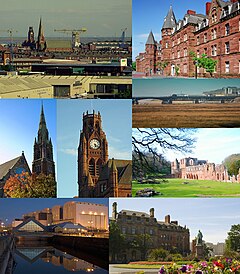
Back Barrow-in-Furness Afrikaans بارو إن فورنيس Arabic باوو-این-فورنس AZB Бараў-ін-Фёрнас Byelorussian Barrow-in-Furness Catalan Barrow-in-Furness CEB Barrow-in-Furness Czech Barrow-in-Furness Welsh Barrow-in-Furness Danish Barrow-in-Furness German
| Barrow-in-Furness | |
|---|---|
 Clockwise from the upper left: Central Barrow with the skyline of Blackpool also visible, Barrow Island, Walney Bridge and Furness College, Furness Abbey, Ramsden Square, Dock Museum and DDH, Barrow Town Hall and St. Mary's Church | |
 | |
Location within Cumbria | |
| Population | 55,489 (2021 Census) |
| Demonym | Barrovian |
| OS grid reference | SD198690 |
| • London | 297 mi (478 km) |
| Civil parish |
|
| Unitary authority | |
| Ceremonial county | |
| Region | |
| Country | England |
| Sovereign state | United Kingdom |
| Post town | BARROW-IN-FURNESS |
| Postcode district | LA13, LA14 |
| Dialling code | 01229 |
| Police | Cumbria |
| Fire | Cumbria |
| Ambulance | North West |
| UK Parliament | |
Barrow-in-Furness is a port town and civil parish (as just "Barrow") in the Westmorland and Furness district of Cumbria, England. Historically in Lancashire, it was incorporated as a municipal borough in 1867 and merged with Dalton-in-Furness Urban District in 1974 to form the Borough of Barrow-in-Furness. The borough was merged into the new Westmorland and Furness district in 2023. At the tip of the Furness peninsula, close to the Lake District, it is bordered by Morecambe Bay, the Duddon Estuary and the Irish Sea. In 2021, Barrow's population was 55,489, making it the second largest urban area in Cumbria after Carlisle, and the largest in the Westmorland and Furness unitary authority.
Natives of Barrow, as well as the local dialect, are known as Barrovian.[1] In the Middle Ages, Barrow was a small hamlet within the parish of Dalton-in-Furness with Furness Abbey, now on the outskirts of the town, controlling the local economy before its dissolution in 1537. The iron prospector Henry Schneider arrived in Furness in 1839 and, with other investors, opened the Furness Railway in 1846 to transport iron ore and slate from local mines to the coast. Further hematite deposits were discovered, of sufficient size to develop factories for smelting and exporting steel. For a period in the late 19th century, the Barrow Hematite Steel Company-owned steelworks was the world's largest.[2]
Barrow's location and the availability of steel allowed the town to develop into a significant producer of naval vessels, a shift that was accelerated during World War I and the local yard's specialisation in submarines. The original iron- and steel-making enterprises closed down after World War II, leaving Vickers shipyard as Barrow's main industry and employer. Several Royal Navy flagships, the vast majority of its nuclear submarines as well as numerous other naval vessels, ocean liners and oil tankers have been manufactured at the facility.
The end of the Cold War and subsequent decrease in military spending saw high unemployment in the town through lack of contracts; despite this, the BAE Systems shipyard remains operational as the UK's largest by workforce (12,000 employees in 2024)[3] and is now undergoing a major expansion associated with the Dreadnought-class submarine programme.[4] Furthermore, in 2023 it was announced that a new class of nuclear submarine, associated with the trilateral AUKUS military alliance, will be designed and principally constructed in Barrow.[5]
Today Barrow is also a hub for energy generation and handling. Offshore wind farms form one of the highest concentrations of turbines in the world, including the second largest offshore farm, with multiple operating bases in Barrow.[6]
- ^ Jenkins, Russell (22 December 2006). "Chocolate blog sends town into meltdown". The Times: 15.
- ^ "Barrow Steelworks". Archived from the original on 19 August 2007.
- ^ BAE Workforce 2024
- ^ Cite error: The named reference
unemploymentwas invoked but never defined (see the help page). - ^ "British-led design chosen for AUKUS submarine project". GOV.UK. Retrieved 25 August 2023.
- ^ Walney £1bn offshore wind farm is world's largest BBC News, 6 September 2018. Accessed: 6 September 2018.
